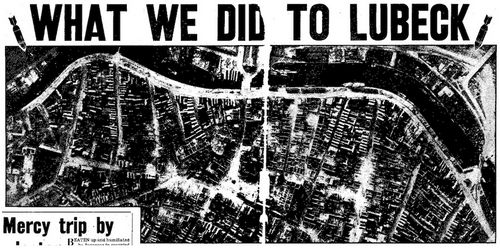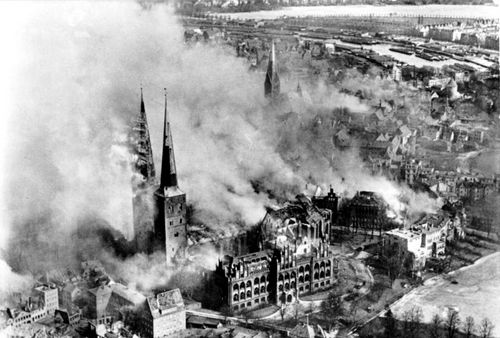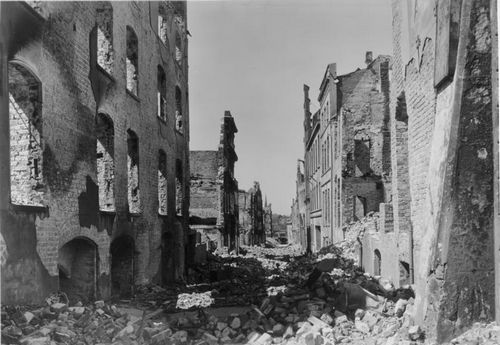The Lübeck Raid 28th March 1942
Following the Area Bombing Directive issued to the RAF on the 14th February 1942, which authorised the targeting of civilian areas, the bombing of Lübeck on the night of Saturday 28th and Sunday 29th March 1942 was the first major success for RAF Bomber Command against a German city. The city was chosen as an incendiary target with a coastal location that would be relatively straightforward to locate. Although beyond the most effective range of GEE, this technology could guide the bombers to "the right area".
That night, 234 Wellington, Stirling, Hampden and Manchester bombers dropped about 400 tons of bombs including 25,000 incendiary devices and a number of 4,000lb "Blockbuster" bombs designed to 'open up' buildings thus giving incendiaries more chance to be effective.

Although not an official first use of the bomber stream tactic, the short timescale of the raid was considered, at the time, to be revolutionary.......234 aircraft crossing the target in less than two hours.
(The bombers used the Shaker technique and bombed in three waves. In Lübeck, an extended period of time was allowed between the waves in order to allow the fires to fully take hold)
RAF Bomber Command lost twelve aircraft in the attack.......7 Wellingtons, 3 Stirlings, 1 Manchester and 1 Hampden.
Air Marshall Harris said, "It was not a vital target, but it seemed to me better to destroy an industrial town of moderate importance than to fail to destroy a large industrial city."

Headline from the Daily Mirror published shortly after the raid.
New equipment, favourable weather, the lack of defences and the historic timber buildings acted in favour of the attacker and Lübeck was severely damaged.

Lübeck Cathedral burning following the air raid (photo credit: Deutsches Bundesarchiv).
Joseph Goebbels, the Propaganda Minister, initially wrote in his diary: "This Sunday is thoroughly spoiled by an exceptionally heavy air raid by the RAF on Lübeck. No German city has ever been attacked so severely from the air".
Goebbels received many phone calls from Karl Kaufmann, the Gauleiter of the area, complaining that he wasn't being given the proper support from Berlin in starting the necessary rescue measures.
Hitler was most "put out" by the negligence of the Ministry of the Interior and so transferred many of their powers to Goebbels (much to his delight).
On April 4th Goebbels writes that, "the damage is really enormous, I have been shown a newsreel of the destruction. It is horrible. One can well imagine how such a bombardment affects the population."
Almost 200 acres (30%) of Lübeck's built up area was destroyed. German sources say that 1425 buildings were totally destroyed and 8411 were less severely damaged. Over 300 people were killed and almost 1000 were injured to varying degrees.

The first wave of bombs included Blockbusters which blew buildings apart. Into these ruins the incendiaries fell, starting the firestorm that caused much of the destruction.
(photo credit: Deutsches Bundesarchiv)
On the 14th April 1942, to help offset the damage the raid had on German morale, Hitler sanctioned what he called, "terror attacks of a retaliatory nature where the greatest possible effect on the civil population was to be expected."
Interestingly, Lübeck was not attacked again thanks to an agreement brokered by a Swiss diplomat who was President of the International Red Cross. The city port was used for bringing in supplies for Allied PoWs which were then delivered to the prison camps by the Red Cross.

A delivery of Red Cross parcels at Stalag Luft III (a PoW camp for airmen)......these parcels would have passed through Lübeck (photo credit: The Real Great Escape website).